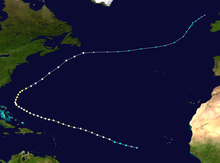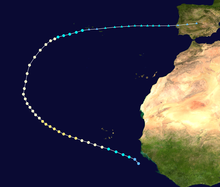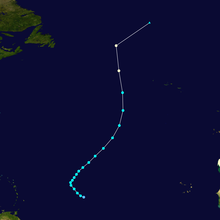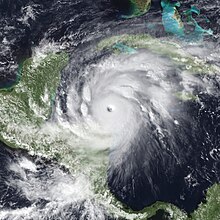| Timeline of the 1998 Atlantic hurricane season | |||||
|---|---|---|---|---|---|
 Season summary map | |||||
| Season boundaries | |||||
| First system formed | July 27,1998 | ||||
| Last system dissipated | December 1, 1998 | ||||
| Strongest system | |||||
| Name | Mitch | ||||
| Maximum winds | 180 mph (285 km/h) (1-minute sustained) | ||||
| Lowest pressure | 905 mbar (hPa; 26.72 inHg) | ||||
| Longest lasting system | |||||
| Name | Georges | ||||
| Duration | 16 days | ||||
| |||||
The 1998 Atlantic hurricane season was an event in the annual tropical cyclone season in the north Atlantic Ocean. This Atlantic hurricane season saw an above-average number of named tropical storms,[1][nb 1] and included a single-day record for number of hurricanes simultaneously in progress, with four active on September 25: Georges, Ivan, Jeanne and Karl.[3] The season officially began on June 1, 1998 and ended on November 30, 1998. These dates, adopted by convention, historically describe the period in each year when most tropical systems form.[4] Even so, this season's first storm, Tropical Storm Alex, did not form until July 27, while its last, Hurricane Nicole, dissipated on December 1.
Altogether, 14 tropical storms formed during the season, including 10 hurricanes of which three intensified into major hurricanes.[1][nb 2] Ten of these storms formed during a five week period at the height of the season, August 19 – September 23.[3] The two most significant storms of the season, in terms of loss of life and damage, were hurricanes Georges and Mitch. Georges moved from the Caribbean Sea to the Gulf of Mexico and ultimately to the United States Gulf Coast, resulting extensive damage and a large number of fatalities, especially in Haiti and the Dominican Republic.[1] Mitch formed over the southwestern Caribbean Sea and then moved slowly over Central America, causing catastrophic flooding and leaving more than 11,000 people dead, making it the second deadliest Atlantic hurricane in history after the Great Hurricane of 1780.[6] Following the 1998 season, the names Georges and Mitch were retired from reuse in the North Atlantic by the World Meteorological Organization.[7]
This timeline documents tropical cyclone formations, strengthening, weakening, landfalls, extratropical transitions, and dissipations during the season. It includes information that was not released throughout the season, meaning that data from post-storm reviews by the National Hurricane Center, such as a storm that was not initially warned upon, has been included.
By convention, meteorologists use one time zone when issuing forecasts and making observations: Coordinated Universal Time (UTC), and also use the 24-hour clock (where 00:00 = midnight UTC).[8] In this time line, all information is listed by UTC first with the respective local time included in parentheses.










